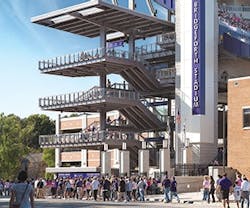Fans Will Have a Field Day at Bridgeforth Stadium
To get ready for some football, James Madison University (JMU) first had to ready Bridgeforth Stadium for renovation. The two-phase project added seating capacity, premium amenities, and a state-of-the-art video scoreboard. The master plan increased seating from 15,000 to 25,000 with ultimate build-out capacity over 40,000.
“Bridgeforth is a world-class facility for the FCS (Football Championship Subdivision). It’s an excellent first step in providing JMU with the flexibility to take advantage of whatever opportunities may be afforded them in the future,” says George Nasis, vice president of Moseley Architects. “Expanding at its current location in the heart of campus creates an iconic image from Highway 81 and the surrounding community that acts as a gateway to JMU.”
Designed with context in mind, stadium architecture engages the campus and becomes a prominent element on the Harrisonburg, VA, skyline. A striking feature is the cantilevered top tier section of the west grandstand, which creates a dynamic form against the backdrop of campus and adjacent mountains.
The palette of exterior materials includes painted steel, precast concrete, masonry, clear glazing with aluminum framing, and metal panel systems, all of which are lifecycle appropriate and respond to adjacent buildings. Select areas feature the school colors of purple and gold.
“You get an SEC football feel when you walk into the place. It’s very impressive. There are two reactions we always get. One is like going through the White House or seeing the Empire State Building for the first time – you just say, ‘Wow,’” says Mickey Matthews, head football coach. “The second is that people are speechless. They just don’t say anything.”
The clean, modern interior creates a sense of openness and provides visual connection to the field. Finishes were selected for durability and ease of maintenance.
The lower concourse level features concessions and a fan shop, while the lower service level includes a commercial kitchen, commissary facility, and loading dock. The club level contains an 8,000-square-foot lounge, and the suite level houses 15 luxury suites and the President’s suite. The upper tier holds a 6,500-square-foot press box.
The complex includes a premium parking deck connected to the club and suite areas and two escalators for VIP access from the main entrance. The indoor and outdoor suites feature interior and exterior flat screen monitors, while the video scoreboard in the south end zone is the largest in the FCS.
A challenging task was finishing the two-year project without disrupting the sporting seasons. While many questioned the schedule’s feasibility, a team commitment enabled completion on time. A phased approach resulted in no net loss of seats during the first year, even though the project required demolishing existing seating, building the new grandstand, and using temporary seating.
The dense, urban nature of the site posed problems to circulation routes around the parking deck, Plecker Athletic Center, Godwin Hall, and stadium field. Additionally, the design of the site, including a flood wall, was coordinated with the Army Corps of Engineers, which had jurisdiction over part of the site located within the 100-year flood plan.
Various other challenges included design, budget, and constructability issues, as well as weather; one of the worst winters in recent history hit during the first phase of the project. However, through ongoing effort and teamwork between the designers, contractors, and university, everyone remained focused. The schedule was maintained, whether it required double shifts or driving concrete foundation piles through snow and ice.
“I have worked on a lot of capital projects over the past 35 years and this project, by far, has been the best one I have ever been associated with,” says Charlie King, vice president of administration and finance at JMU. “The professionalism and teamwork on this project is a model for how capital projects should be managed.”
The aim of furthering the JMU brand and creating a strengthened home field advantage was achieved, says Nasis. “The project has dramatically improved the game day experience for the community and formed the type of enduring, energy-filled environment that will build a proud football tradition,” he adds.
